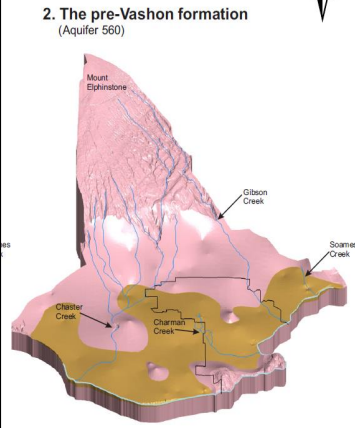A decade of aquifer monitoring and updated models confirm the Town of Gibsons’ water supply is secure, with manageable demand and no signs of contamination or depletion.
Gibsons council members received the encouraging news about the health of the aquifer system during their May 20 Committee of the Whole.
In presenting the information, natural asset technician Michelle Lewis highlighted two major initiatives: the LeapFrog model update and the annual groundwater monitoring report.
She explained that the LeapFrog model is a 3D conceptual model originally developed by Waterline Resources Inc. in 2013, which has been enhanced with new geological and hydrogeological data collected over the past decade.
SCRD, Gibsons aquifer ‘lobes’ separate
One of the most significant discoveries involves the relationship between the Gibsons and Soames aquifer lobes.
Lewis said that based on drilling data, researchers now have greater confidence that the boundary between these two sections is disconnected.
Lewis explained that this is particularly important because the Sunshine Coast Regional District operates wells in the Soames lobe.
The monitoring program also revealed that when Well 6 in Upper Gibsons came online, the town's water service capacity expanded from serving 73 per cent of Gibson's population to 100 per cent, excluding some fire flows.
Lewis said this increased demand resulted in a slight, expected decrease in water levels near Well 6, but emphasized this doesn't indicate overall aquifer depletion.
Water use and quality
Despite population growth and the addition of Zone 3 to the town's water system, water demand has increased by only 5.1 per cent since 2021, said Lewis.
She also said the town's total licensed volume of 1.014 million cubic metres remains well below 80 per cent of the annual licence capacity, which indicates sustainable usage levels.
Water quality has remained consistently high throughout the monitoring period, with no signs of contamination or saltwater intrusion, according to Lewis.
Future priorities
A new shift will focus on identifying specific recharge locations rather than broad areas, Lewis said.
This approach will help protect critical recharge points from pollution while ensuring development doesn't interfere with natural water flow patterns.
Trevor Rutley, director of infrastructure services, highlighted a recommendation to revisit the aquifer flow model –– analyzing all inputs and outputs –– as part of future water licence applications with the province.
Coun. David Croal asked about potential rainwater collection impacts and whether residential rain barrel systems could affect aquifer recharge.
Both Lewis and Rutley said residential-scale water collection would have a negligible impact on the aquifer, given the scale and natural overflow characteristics of typical rain harvesting systems.
Looking ahead, Lewis said the 2025 annual groundwater monitoring is scheduled for September, with results expected in the first quarter of 2026.
The monitoring includes having Waterline Resources Inc. come to Gibsons to collect data from the wells and conduct conditional assessments.
Jordan Copp is the Coast Reporter’s civic and Indigenous affairs reporter. This reporting beat is made possible by the Local Journalism Initiative.
Words missing in article? Your adblocker might be preventing hyperlinked text from appearing.



